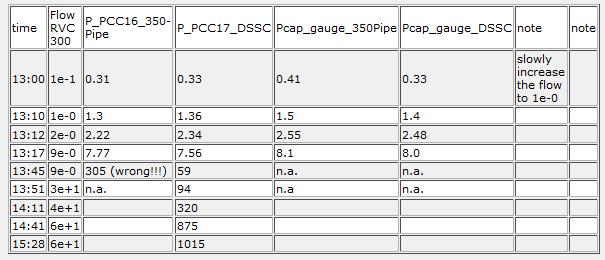.¶
Venting DSSC Chamber¶
The original documentation can be found in the Alfresco Document Library.
Procedure¶
Step 1:
Make vacuum in the venting lines because when we open the venting valves the pressure in the chamber will be in e-1 mbar range and we want to have a pressure behind the venting valves also in the e-1 mbar range.
- close the rough vacuum valve to turbos
- fully open the RVC300 valve for venting. Press Edit to be able to change the flow.
- open the rough vacuum valve to the venting line
- wait for pressure to be in the low -1 mbar
- open the rough vacuum valve to the turbos again while leaving the valve to venting lines open.
- Status: we have rough vacuum going to the turbos and up to the venting valves, which are still closed
Step 2:
- switch off the two turbos
- wait for the turbos to be completely down and for the pressure to be in the e-2 mbar range. TP2 usually goes down faster than TP1.
- When turbo are completely off, after 1 hour and 20 minutes since pressing stop pumping, the pressure is 7 e-3 mbar.
- Open the venting valves, the pressure will see no difference because behind the venting valves there is the same vacuum as in the chamber approximately. To open the venting valves you need 24 V at the cables.
Step 3:
Preparation for venting
- Close the rough vacuum valve to the turbos
- close the RVC 300 for venting
- close rough vacuum valve to venting line
- Status: venting valves are open, rough vacuum valves are all closed, RVC300 for venting is closed.
Step 4:
Start venting
- Open N2 line to fill the line behind the RVC 300, hear overpressure at the overpressure valve near RVC300.
- slowly open the RVC 300 to let N2 in.
- At 1.0 mbar l/s we reach 1mbar
- The chamber has previously been pumped at a maximum rate of ~2mbar/sec. Thus it should be save to vent it at ~1mbar/sec.
- In 1.0 hours we go from 1 mbar to 1000 mbar, and leave it a 1000 mbar for 15 minutes to make sure it is really vented.
- Close the gate valves of the turbos, close the venting valves, close the RVC 300 valve, close the N2 valve.
- Last step is to slowly open the full metal leak valve to make sure there is no overpressure in the chamber and to make sure it is fully vented.
- The last entry about the venting procedure in Elog.
